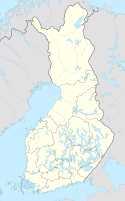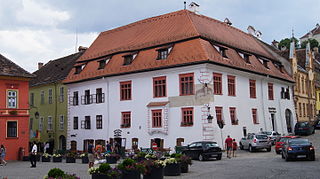
Sighișoara is a municipality on the Târnava Mare River in Mureș County, central Romania. Located in the historic region of Transylvania, Sighișoara had a population of 23,927 according to the 2021 census. It is a popular tourist destination for its well-preserved old town, which is listed by UNESCO as a World Heritage Site. The town administers seven villages: Angofa, Aurel Vlaicu, Hetiur, Rora, Șoromiclea, Venchi, and Viilor.

Rauma is a town in Finland, located on the western coast of the country. Rauma is situated in the Satakunta region, along the Gulf of Bothnia. The population of Rauma is approximately 39,000, while the sub-region has a population of approximately 66,000. It is the 29th most populous municipality in Finland.

Hollókő is a village in northern Hungary, located in Nógrád County. The village, which was constructed in the 13th century and developed in the 18th and 19th centuries, is a well-preserved ethnographic village of the Palóc people, with traditional wooden architecture and layout of buildings, farms, and orchards. Because of its exceptional preservation and testimony to rural life before the arrival of modern farming practices, the village was inscribed as a UNESCO World Heritage Site in 1987. Its name means "Raven-stone" in Hungarian.

Kraków Old Town is the historic central district of Kraków, Poland. It is one of the most famous old districts in Poland today and was the centre of Poland's political life from 1038 until King Sigismund III Vasa relocated his court to Warsaw in 1596.

Turku Cathedral is the only medieval basilica in Finland and the Mother Church of the Evangelical Lutheran Church of Finland. It is the central church of the Lutheran Archdiocese of Turku and the seat of the Lutheran Archbishop of Finland, Tapio Luoma. It is also regarded as one of the major records of Finnish architectural history.

The Old Town is the name popularly given to the oldest part of Scotland's capital city of Edinburgh. The area has preserved much of its medieval street plan and many Reformation-era buildings. Together with the 18th/19th-century New Town, and West End, it forms part of a protected UNESCO World Heritage Site.

The Saracen's Head is the name formerly given to a group of late medieval buildings in Kings Norton, Birmingham. The buildings, together with the nearby Old Grammar School, won the BBC Restoration series in 2004. Following the restoration project, the Old Grammar School, Saint Nicolas Church and the Tudor Merchant's House were given the collective name of Saint Nicolas Place.
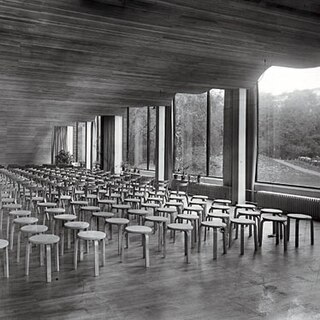
The architecture of Finland has a history spanning over 800 years, and while up until the modern era the architecture was highly influenced by Sweden, there were also influences from Germany and Russia. From the early 19th century onwards influences came directly from further afield: first when itinerant foreign architects took up positions in the country and then when the Finnish architect profession became established.

The Plaza Mayor in Trinidad, Cuba, is the historic centre of the town, declared a UNESCO World Heritage Site in 1988.
Holy Cross Church, or variants thereof, may refer to:

Nea Moni is an 11th-century monastery on the island of Chios that has been recognized as a UNESCO World Heritage Site. It is located on the Provateio Oros Mt. in the island's interior, about 15 km from Chios town. It is well known for its mosaics, which, together with those at Daphni and Hosios Loukas, are among the finest examples of "Macedonian Renaissance" art in Greece.
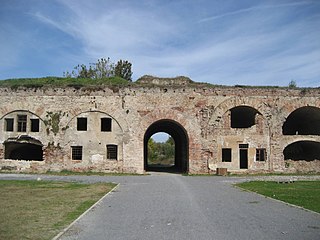
The Fortress of Brod is a fortress in Slavonski Brod, Croatia with significant cultural heritage. The fortress was constructed in the 18th century by the Archduchy of Austria to create a defense against the Ottoman Empire.
This article covers the architecture of Estonia.
Monuments of Kosovo comprise all the monuments that are located in Kosovo.

The Church of the Holy Cross is a medieval fieldstone church in Rauma, Finland. It is located in the UNESCO World Heritage Site of Old Rauma. The church stands by the small stream of Raumanjoki.
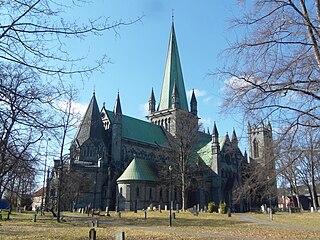
Church building in Norway began when Christianity was established there around the year 1000. The first buildings may have been post churches erected in the 10th or 11th century, but the evidence is inconclusive. For instance under Urnes Stave Church and Lom Stave Church there are traces of older post churches. Post churches were later replaced by the more durable stave churches. About 1,300 churches were built during the 12th and 13th centuries in what was Norway's first building boom. A total of about 3,000 churches have been built in Norway, although nearly half of them have perished. From 1620 systematic records and accounts were kept although sources prior to 1620 are fragmented. Evidence about early and medieval churches is partly archaeological. The "long church" is the most common type of church in Norway. There are about 1620 buildings recognized as churches affiliated with the Church of Norway. In addition, there are a number of gospel halls belonging to the lay movement affiliated with the Church of Norway as well as churches belonging to other Christian bodies. Until the 20th century, most churches were built from wood. 220 buildings are protected by law, and an additional 765 are listed as valuable cultural heritage.

Rauma Old Town Hall is a building located in the UNESCO World Heritage Site of Old Rauma in Rauma, Finland.

Kalix Church is a medieval Lutheran church in Kalix in Norrbotten County, Sweden. It belongs to the Diocese of Luleå. The church is the northernmost medieval church of Sweden.

The architecture of Albania is a reflection of Albania's historical and cultural heritage. The country's architecture was influenced by its location within the Mediterranean Basin and progressed over the course of history as it was once inhabited by numerous civilisations including the Illyrians, Ancient Greeks, Romans, Byzantines, Venetians, Ottomans as well as modern Austro-Hungarians and Italians. In addition, missionaries, invaders, colonisers and traders brought cultural changes that had a large profound effect on building styles as well as techniques.
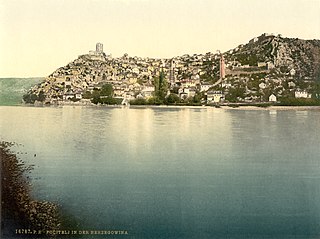
Walled town of Počitelj is a medieval fortified nucleus of Počitelj historic village, in the municipality of Čapljina, Bosnia and Herzegovina. Due to its significant architectural and urbanistic historical value, it is considered an open-air museum. The Walled town is nested in a natural karst amphitheater along the left bank of the Neretva river, on the main road Mostar-Metković. The walled nucleus is protected as a National Monument of Bosnia and Herzegovina. The architectural ensemble of Počitelj is also proposed as such for inscription into the UNESCO's list of World Heritage Sites. The bid for inscription is currently placed on the UNESCO Tentative list.

